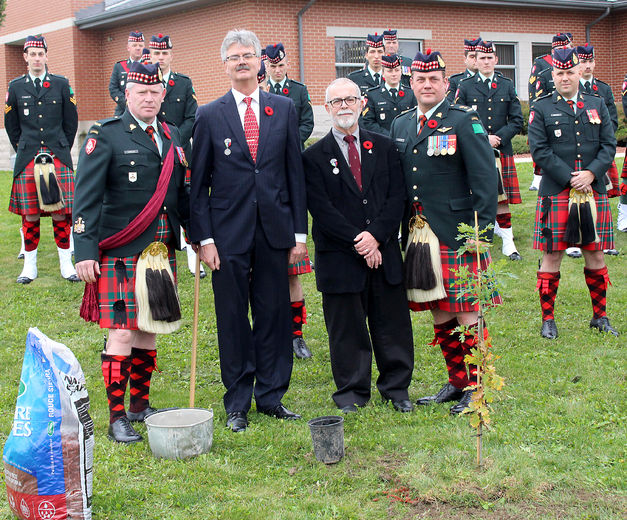An oak sapling planted on the front lawn of the Colonel E.M. Ansell Armoury in Chatham may not yet catch the eye of many a passerby.
But, the thin, fragile stick, which will someday become a mighty oak tree, has a connection to a battle fought a century ago that is credited for the birth of national pride due to the heroic efforts of brave Canadian soldiers in winning the Battle of Vimy Ridge.
A ceremony was held a Saturday to plant the sapling and tell the story of its origins.
Lt. Leslie Miller, who was looking for a souvenir at Vimy Ridge in 1917, found a half-buried oak tree and gathered a handful of acorns to bring home. He later planted them on his family’s farmland, that is now part of a church property in Toronto.
Fast-forward a 100 years later and a sapling from one of those century-old oak trees has been planted here thanks to the efforts of Chatham resident Henry Taekema and local military historian Jerry Hind.
Taekema said while doing research to plan a trip to Vimy Ridge in France to mark the 100th year of Canada’s most celebrated military victory, he discovered the Vimy Oaks project, to have saplings, descendants of the Miller trees, be planted across Canada in 100 communities.
He enlisted the help of Hind and together, they were able to secure two saplings, including one that has already been planted at the Windsor Armoury, which is home to the Essex & Kent Scottish Regiment.
Noting that there are no longer any Canadian veterans alive who served in the First World War, Taekema said to those attending the planting ceremony, “they have no voice left but ours.
“It’s our task to remember,” he added.
Taekema told those gathered that “this little tree is really a tangible connection to that the place and time.”
Hind said, “war is nasty business . . . and Vimy Ridge was one of the more nasty occasions to show that.”
He noted this effort is “a way of saying to the whole Canadian experience that finally, the Canadians that went to Vimy and didn’t return are now recognized with the planting of a tree from Vimy.”
A total of 16 men from various communities across Chatham-Kent were killed within days after the battle began in April 9, 1917.
The Essex and Kent Scots are proud that one of their own, Lance-Sergeant Ellis Sifton, from nearby Wallacetown, in Elgin County, who was awarded the Victoria Cross for his efforts in charging and taking out one of the German machine-gun nests that were inflicting heavy casualties.
Chatham Coun. Darrin Canniff, who attend the ceremony on behalf of the municipality, said the event has special significance to him, because his grandfather, Wilfred Littlejohns, of Highgate, fought in the Battle of Vimy Ridge and survived.
Just before Christmas 2009, Canniff unexpectedly received several letters that were written by his grandfather during his time serving as a sergeant with the First Battalion Expeditionary Force during the First World War.
He said this prompted him to do his own research and to learn that what the Canadian military did during the Battle of Vimy Ridge “was really quite amazing . . . and established the Canadian military as one of the best in the world.”
Phil Berthiaume, Honourary Colonel of the Essex & Kent Scots, said Vimy Ridge is “our story, is our history.”
He noted the planting of this tree “helps bring our military history and heritage to the community.”
The featured image is about: An oak sapling that is a descendant from an oak tree on the battle field of Vimy Ridge, was planted at the Col. E.M. Ansel Armoury in Chatham, Ont. on Saturday November 4, 2017. Pictured from left, are Regimental Sgt. Major Brian Jordan, Henry Taekema and Jerry Hind, local residents who arranged to get the oak sapling, and Lt. Col. John Hodgins, Commanding Officer. Ellwood Shreve/Chatham Daily News/Postmedia Network
eshreve@postmedia.com
@DailyNewsES



